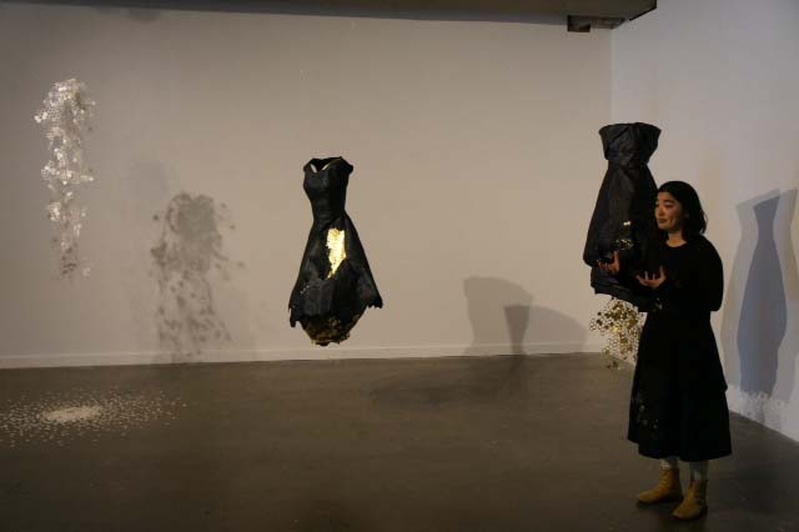Can you describe your work as a designer? Are there particular aspects of your design that might identify you as Nikkei?
My clothing designs come out of the concepts I explore in my art practise. I use the same representational motifs from my art work in my clothing designs.
For example in my “Hive” series I use the image of a honeycomb cell to represent work, labour, and creation of the working class. I make a paper lace of honeycombs, like an ethereal screen or barrier, and a momigami paper dress with an image of gold smoke rising from a dark crevice or gold splatter across honeycomb seams. In my clothing design work, I take the same honeycomb motif and apply it onto original designed clothing as a screen print or stitched appliqué.
In a more current example, for an upcoming collection, I stitch a gold scar across the back of a dress as a kintsuji motif. The idea behind this new collection is healing wounds of war and violence. I created this motif to honour our humanity and weathered histories with compassion, and to renew from the darkness whittled and learned with heart oceans deep, and radiant.
The stories behind my designs relate to issues of identity, and to my Japanese heritage.
What role has your ethnic identity played in your evolution as an artist? Is it Japanese/Canadian or vice versa?
Being Japanese Canadian is intrinsic to the work I do because issues of identity are what I draw on in my practise and connection to my heritage is referenced in the materials and processes I choose.
Can you please say a little more about both the Japanese and Canadian connections?
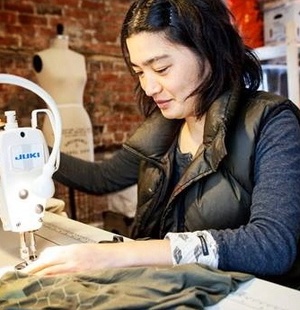
I am drawn to working with some pre-industrial Japanese materials and processes for example: washi paper, bamboo, dying with indigo and charcoal, boro patchwork, or using konnyaku to size paper. However, I also utilize contemporary methods and materials that I have learned as well: industrial machine sewing, contemporary screen printing, millinery wire work, plastic materials for structure, etc.
I integrate both contemporary and traditional materials and methods in my artistic practise.
How have issues of racism (e.g., Aboriginal women) touched your own life and art?
Canadians are so uncomfortable with racism, there is an unwillingness to discuss it because it challenges constructed ideas of national identity such as peacekeeping and tolerance.
Ideas like multiculturalism and pluralism have penetrated the notion of Canadian social identity, and therefore the concept of racism is perceived as foreign or “un-Canadian”.
Being a non-indigenous, racialized Canadian, I grew up in a social environment that denied and therefore silenced racialized experiences. When there is an absence of acknowledgement or words to identify what it is actually being experienced, these racialized experiences accumulate and became internalized. Internalizing racism lead me to want to disconnect with who I am, my family, my community, as though I could alienate the parts of me that were perceived as “non-white”, so that somehow I would be seen, heard, included, and valued equally. This is not a unique experience for racialized people and yet racism as a social phenomena is something Canadians are in denial about.
Any personal experiences of racism/intolerance that you can share?
There isn’t any one incident that stands out. If it does, it’s only because I may have started to become aware of what I was experiencing. And personalized racism is where my awareness began, but that’s not where social inequity is. But those personal experiences are a result of inequity.
This country is founded on the principles of racism. From acts of genocide to legislated racism toward Indigenous People, as well as legislated racism towards other racialized groups, these acts are our nation’s building blocks, and have a significant causal effect of why and how we are here today.
What is the result of this then?
We no longer live in an era where racism looks like hate. Racial oppression is institutional and woven within our structure and social perceptions, as it intersects with other issues including poverty, gender, and “shadism”.
Owning one’s own heritage, leaning into family story, connecting to lineage and understanding self within a historical context can be a personal act that is healing, grounding, and reclaiming. But it’s when Canadians can dialogue about and own issues of institutionalized racism, I think that’s when an honest progression toward social equity can begin.
Do you somehow express these ideas through your designs?
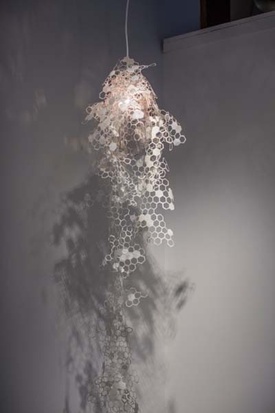
My artistic practise is primarily concerned with issues of inequity as it relates to identity. For example, one of my Hive paper sculptures may look like fragile honeycomb lace. Initially the piece had a light source centred inside emanating outward through the screen of paper lace casting shadows. The hexagons from the negative space of the cut outs are assembled on the floor directly underneath the piece like “ground zero” impact zone that spreads outwardly. Throughout this series, I utilize a contrast of colours and textures to tell a story of a light within that transgresses beyond barriers in society and work creating impact.
How do you inform/nurture your “Nikkeiness”? How might this be different from how Nikkei who have a more distant connection to Japan e.g., pre-WW2 JC community?
I look to my family lineage as craft makers to inform my “Nikkeiness”. I draw from family stories of how we survived and thrived through desperate times. I reach into the ethic of “shokunin”, into the honesty of materials, Buddhist philosophy and respect, and teachings from the natural world. I was introduced to this world view and these ways of connecting through my mother, uncle and aunt, and my elders, and I continue learning throughout my life.
Can you please explain how the philosophy of “shokunin” affects how you approach your work differently than other designers?
My craft practise connects me through lineage, to my ancestors. As I make, I think about how my maker hands connect me across the ocean divide beyond land and time.
I work to refine my practise—to be open and adaptable to relevant approaches and alternative perspectives, to become more intuitive than I was. Over the years, I continue to use materials, methods, and tools from those who I have learned from and throughout various trades, and integrate approaches as I continue to hone my craft. To create a practise that is wholistic in its philosophy, is when the act of making becomes a statement of one’s life, I suppose—a constant whittle.
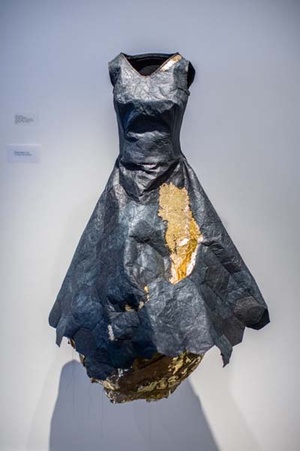
Have other Nikkei and/or Japanese artists influenced you at all?
In my youth, I was inspired by Yumi Eto’s story. She was the only Japanese Canadian fashion designer that I had heard of and created beautiful work. Her connection to the west coast landscape was something I also felt deeply connected to growing up. As a youth, she seemed tangible to me yet doing seemingly intangible things, so she was an example to me that my dreams were possible.
Can you please tell us a little more about Yumi Eto? Can you describe her designs? Is she still working?
Her work had strong tailored influences, but juxtaposed with soft, organic shapes and textures. I haven’t followed her progression since the late ’90s, but I think she has moved on to work as a director for Aritzia in Vancouver.
Does being an artist give you any particular freedom to explore who and what you are? Are there still areas of particular interest that you want to explore e.g., Japanese culture?
I have a responsibility as a practising artist because through my work I have a platform to communicate to an audience, explore ideas, materials, and cumulative experiences. It is how I commune with others through collaborations, and connect with community.
I have always wanted to learn Kendo.
What is the importance of having a community of Nikkei artists to advance the understanding of ourselves?
Artists are a key to communicate identity, lived experiences, and shared histories in any community. Artists can be influenced by social patterns and change, and can reflect this back into the community through their work.
As each successive generation becomes increasingly disconnected from ancestral heritage, cultural celebrations can be impotent without a contextual understanding of this disconnection. Artists in our community can delve deeper into their experiences, explore questions, and translate the unknown through their art making. These explorations can give us insight into our own explorations, or incite our own investigations into who we are and why, and how we, as a community, impact society within the wider Canadian landscape.
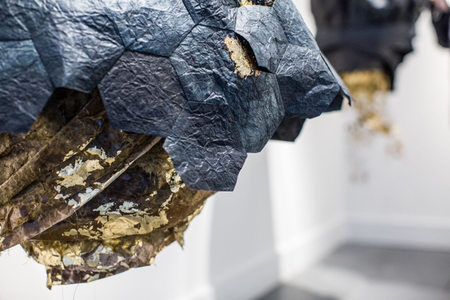
Finally, what is in the future for you?
I’m currently working on a new collection as I had mentioned earlier. It will involve new motifs like kintsuji, knitted patches in Japanese paper and linen yarns, and boro stitchwork. I will also incorporate some backyard hand dyeing in indigo and sumi or charcoal in this series, so I’m looking forward to that this summer.
© 2015 Norm Ibuki


